In 2015, the Montana Legislature passed the bipartisan Health and Economic Livelihood Partnership (HELP) Act, extending health care coverage to Montanans ages 19 to 64, making less than 138 percent of the federal poverty level.[1] At that time 19,547 American Indian/Alaska Natives (AI/AN) were projected to be eligible.[2] Medicaid expansion was re-authorized in 2019 and will need reauthorization again in 2025.[3]The program has provided tens of thousands of Montanans with lifesaving and affordable medical care and helped communities, businesses, and Montana’s economy. As of January 2024, 90,003 Montanans are enrolled, 16 percent of them American Indians.[4]
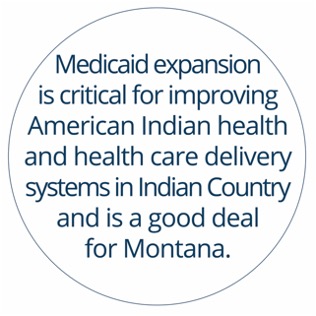
Since the COVID-19 pandemic, Medicaid enrollment numbers for AI/AN numbers have fluctuated. The Coronavirus public health emergency hit Tribal communities especially hard. According to data from 2021, while American Indians comprise 6-9 percent of the state’s population, they accounted for 17 percent of the COVID-related deaths in Montana.[5] Federal provisions for COVID brought certain improvements like 100 percent federal reimbursement at urban Indian health facilities and continuous enrollment in Medicaid.[6] Continuous enrollment prevented individuals from losing or reapplying for coverage during the COVID-19 pandemic. However, the federal government allowed states to redetermine eligibility for Medicaid in April of 2023. The redetermination process is when the state reassesses whether an individual still qualifies for Medicaid coverage based on the current information they have on hand. Between the time redetermination first began and November 2023, a 23 percent (or 12,857 individuals) enrollment drop rate occurred in Medicaid AI/AN recipients. Most people lost coverage for procedural reasons, like not returning a form in time or getting dropped during the department's backlog renewal process. The drops in enrollment mean fewer people accessing services and a loss of funding to those facilities being accessed.
As of November 2023, 42,907 American Indians are accessing Medicaid coverage, with 14,057 accessing the coverage because of Medicaid expansion.[7] Not only does this have the potential to help close the staggering American Indian health disparities gap, but it also brings much-needed health care dollars into Indian Health Services (IHS), Tribal, and urban health (I/T/U) facilities, which can bill Medicaid for services.
Additionally, all services provided at IHS, including written care coordination agreements between IHS and non-IHS providers, qualify for 100 percent federal reimbursement and are provided at no cost to the state Medicaid program. Medicaid expansion is critical for improving American Indian health and health care delivery systems in Indian Country and is a good deal for Montana.
In 2009, prior to Medicaid expansion, Montana ranked first among states with the highest number of uninsured American Indians.[8] However, the uninsured rate for American Indians age 19 to 64 has steadily decreased since the 2010 American Affordable Care Act (ACA) passed, with an estimated 53 percent uninsured in 2012 to an estimated 32 percent in 2022.[9]
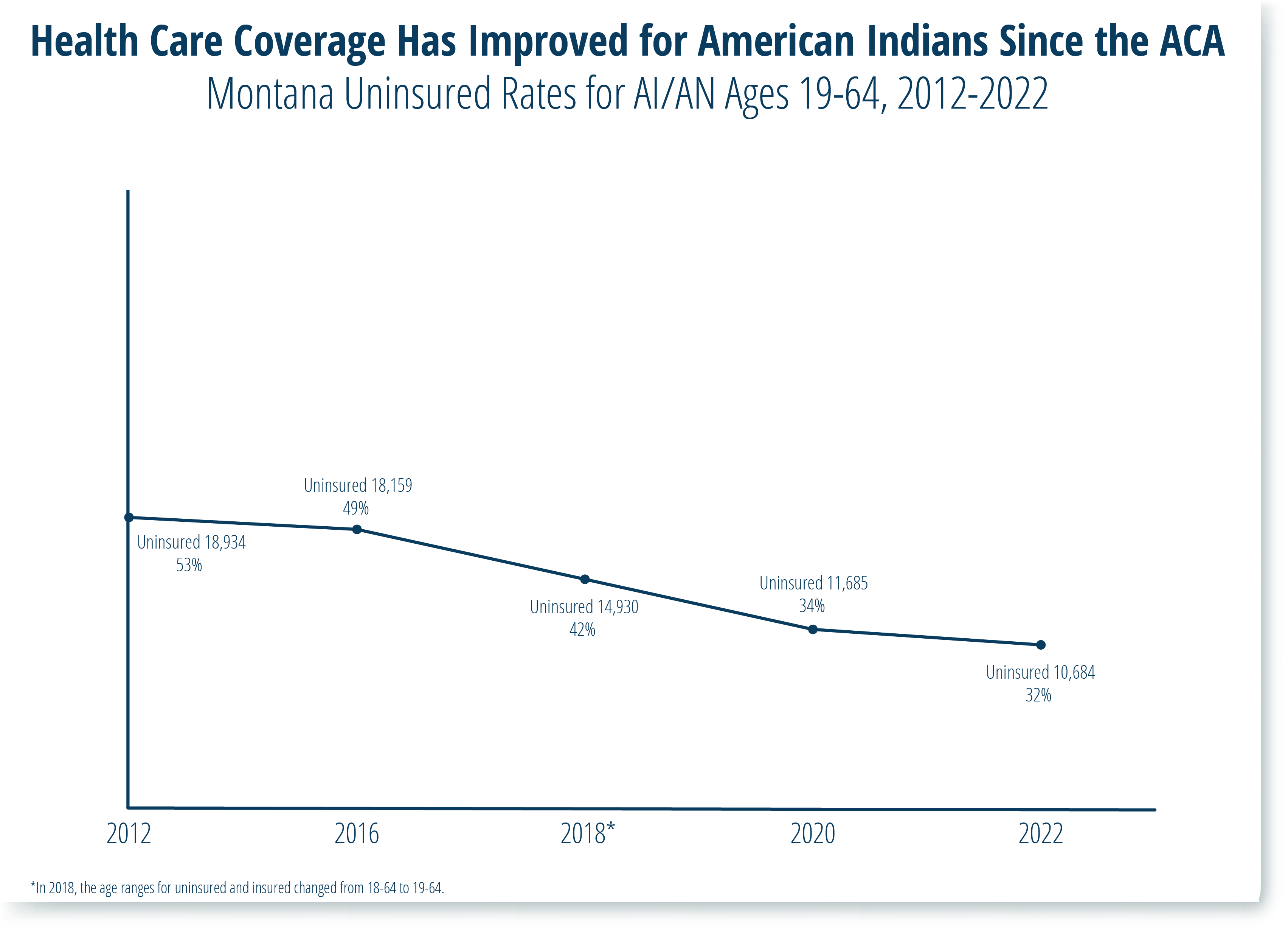
Indian, Tribal, and Urban Facilities Provide Vital Health Care
IHS provides health care services to 2.6 million American Indians and is organized into 12 regions, each administered by an office.[10] The Billings Area Office serves more than 70,000 American Indians in Montana and Wyoming.[11] Services generally consist of primary medical care, though dental and some specialized practice areas are also offered. In Montana, services are delivered through:
Availability of services varies widely from one facility to the next and can be delivered either directly at I/T/U facilities or through services purchased from private providers, which are referred to as Purchased/Referred Care (PRC).[14] PRC enables IHS beneficiaries to access care when a local IHS facility cannot provide it.[15] But IHS is not a health insurance program, and American Indians cannot receive health care outside of I/T/U facilities without incurring a cost for services provided.
While individuals are eligible for direct care services at any IHS facility if they are citizens or descendants of a citizen of a federally recognized Tribal Nation, eligibility for PRC services is much stricter. Individuals must reside within a contracted health service delivery area and be citizens of the local Tribal Nation on whose reservation the referring IHS facility is located.[16] Further, there must be dollars available in the local IHS budget to cover the cost of those services.
The Indian Health Service Has Provided Health Care Since 1955[17]
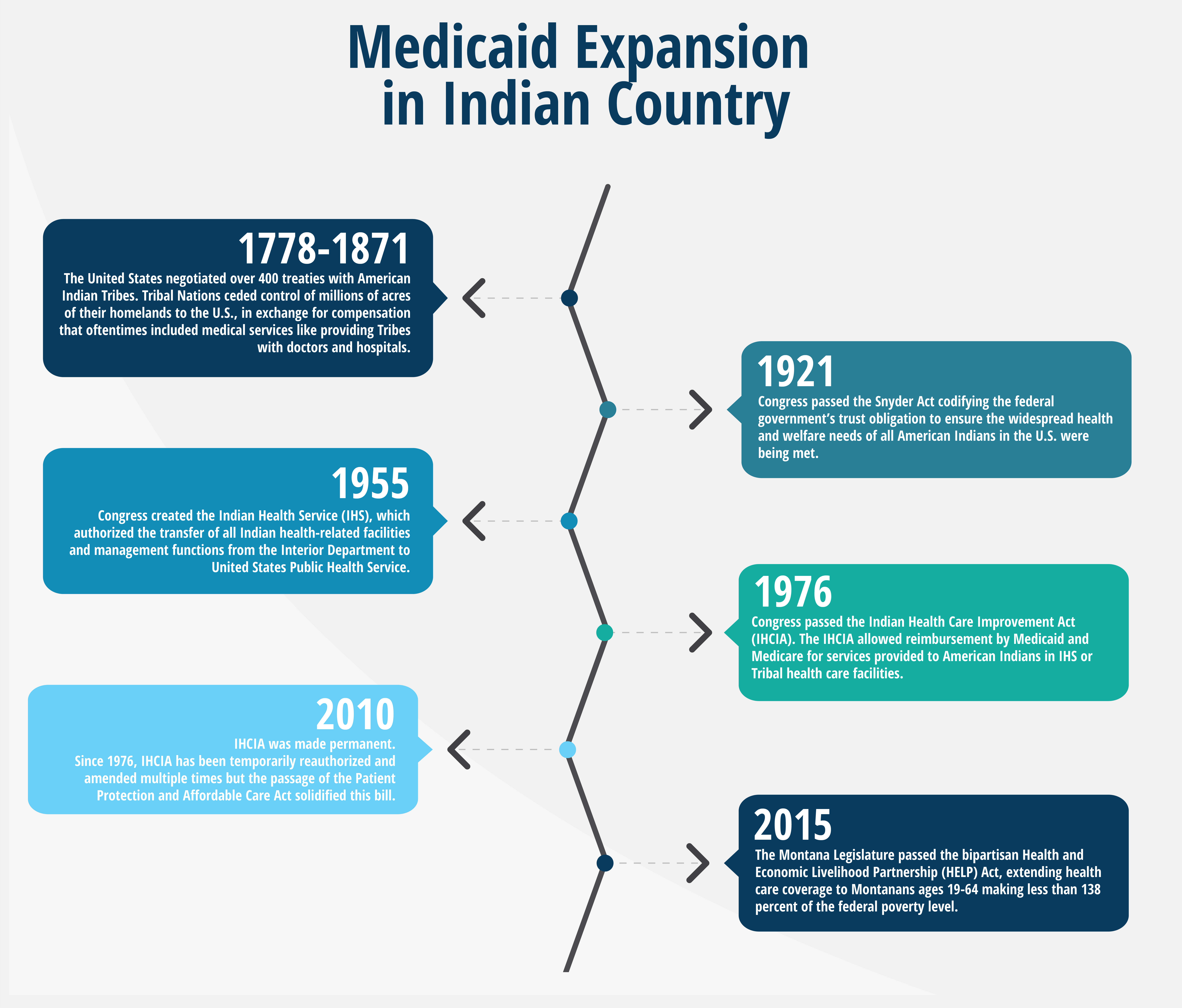
Chronic IHS Underfunding Affects American Indian Health
Due to severe and chronic underfunding of IHS, direct services are restricted by limitations on medical supplies, equipment, and medical staff. The IHS manual notes that all services are provided “as available at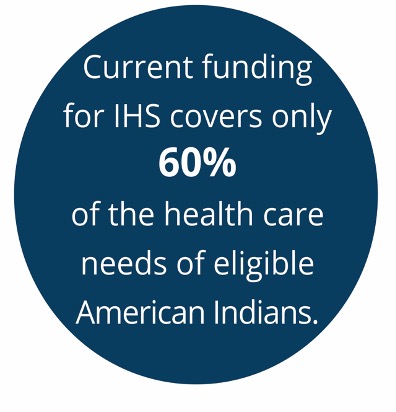 IHS facilities or on a contractual basis when PRC funds are authorized,” but “limitations of funds, facilities, or staff may result in services not being available to all persons who come within the scope of the program.”[18] Services obtained under PRC are limited as well. Life-or-limb illnesses and injuries are given the highest priority and are often the only referrals approved.
IHS facilities or on a contractual basis when PRC funds are authorized,” but “limitations of funds, facilities, or staff may result in services not being available to all persons who come within the scope of the program.”[18] Services obtained under PRC are limited as well. Life-or-limb illnesses and injuries are given the highest priority and are often the only referrals approved.
However, even high-priority referral requests cannot be approved once funding has run out. In some years, funding runs out mid-fiscal year, forcing individuals to forego needed health care.[19] IHS has acknowledged that this “renders the PRC program to authorize care at restricted levels and results in a rationed health care system.”[20] Additionally, IHS pharmacies generally do not carry all medications, only those proven to be most cost-effective.[21]
Although funding for IHS has increased by 94 percent since 2008, IHS remains severely underfunded.[22] While other federal health programs such as Medicaid and Medicare receive automatic funding increases to cover the total eligible population, IHS funding is discretionary, contingent upon an annual appropriation by Congress. Current funding for IHS covers only 60 percent of the health care needs of eligible American Indians.[23]
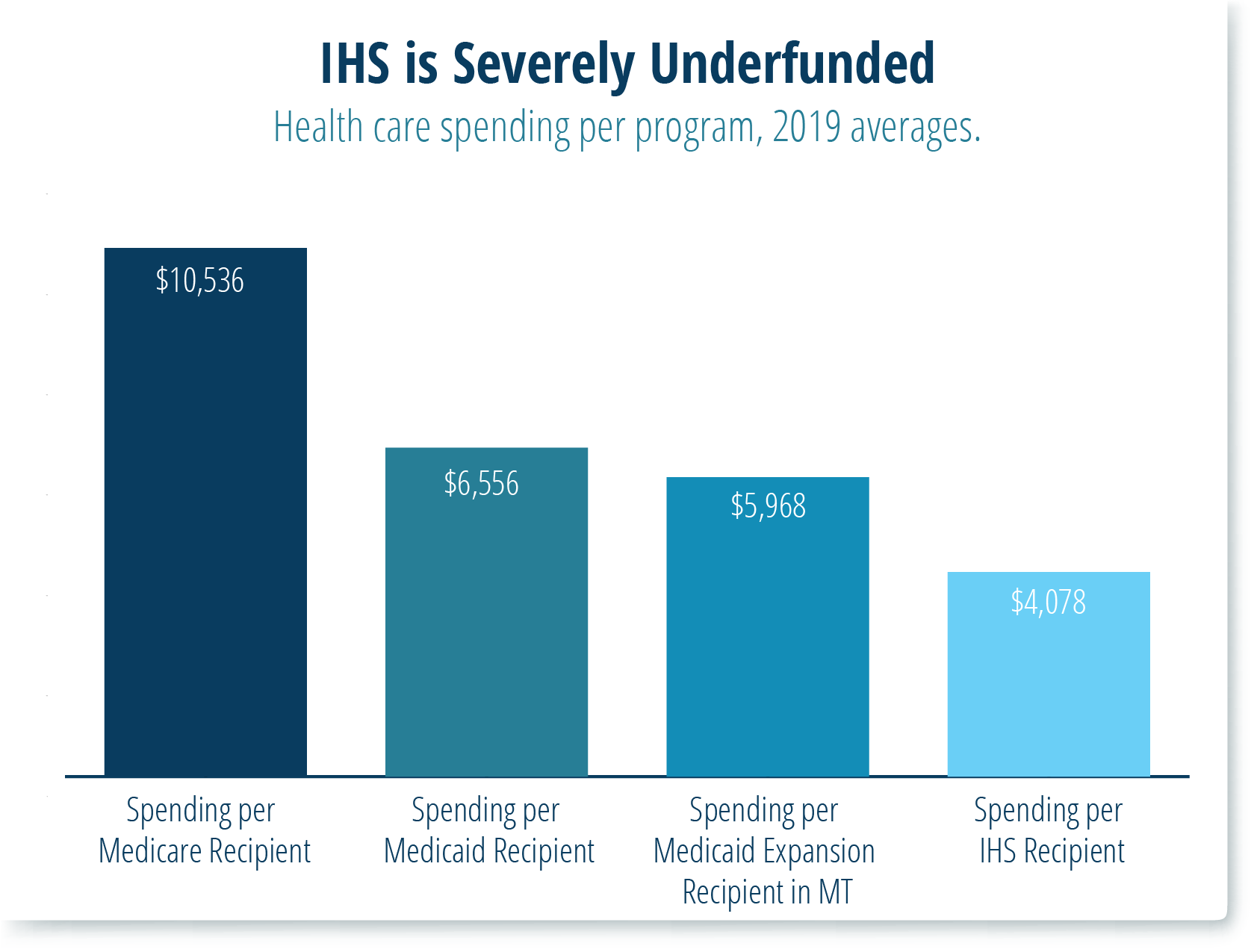
Compared to other government-funded health programs, IHS spends far less per recipient. In 2019, the national government spending on adult Medicaid per recipient was $6,556 and $10,536 per Medicare recipient.[24] In Montana, the average cost per enrollee on Medicaid expansion was around $5,968 in 2019.[25] The amount spent per person through IHS in FY 2019 was $4,078.[26]
In addition to funding shortages and the resulting limitations on the availability of services, the physical residence of where an eligible American Indian lives plays a role in accessing IHS services. American Indians cannot take advantage of IHS services if IHS or Tribal facilities are not located within a reasonable distance from where they reside. Additionally, as noted earlier, American Indians who live off their reservation and outside their IHS’s PRC delivery area often no longer qualify for PRC services.[27] And if they do not reside in one of five urban centers with an Indian health facility, they will be unable to access health care through IHS.
Compounding this issue is that most American Indians historically tend not to carry health insurance. Prior to the ACA, private insurance was most frequently accessed as an employee benefit. Because colonialism has suppressed economic opportunities for American Indians, 35 percent have incomes below the poverty level, and 13.7 percent are unemployed, creating another barrier to accessing health insurance.[28] For many, seeking care outside of IHS has not always been an option until the expansion of Medicaid.
Limited access to adequate health care through IHS, coupled with a low occurrence of individuals with private insurance, has contributed to staggering health disparities experienced by American Indians today. This includes a highly disproportionate disease burden and a lower life expectancy when compared with all other Americans.[29] Between 2011 and 2015, American Indians in Montana lived 16-19 years less than the rest of the state’s white population, with American Indian men expected to live to age 59 and women to 63.[30]
Improving Access to Care for American Indians and State Fiscal Benefits
Due to the United States’ failure to meet treaty obligations, adequate health care has been lacking in Indian Country for generations. The pandemic laid bare this inadequacy and highlighted the need for improved access to health care through Medicaid expansion. Medicaid is a critical resource for eligible American Indians who either have no insurance or are dealing with inadequate care through IHS’s rationed system. Additionally, care is not restricted to IHS’s reservation or urban care facilities, and as with other Medicaid beneficiaries, American Indians can access care at any provider participating in the state’s Medicaid program. However, if services are accessed through IHS or an approved care coordination agreement, the federal government will pay 100 percent of the billed cost with no fiscal impact to the state.[31]
Not only does Medicaid enable beneficiaries to access comprehensive health care, but it also provides them with an important financial safety net. Likewise, if an uninsured Tribal citizen living off-reservation is injured and seeks treatment at the nearest clinic, they will be liable for the cost of treatment unless several variables are in place: the patient happens to reside within their reservation’s IHS contract health service delivery area, the IHS happens to have a contract with that particular provider, the IHS is willing to approve the “referral” post-service, and they happen to have available funding to cover the cost. If any of the variables is absent, the patient will be liable for the bill. But if the patient has Medicaid coverage, the provider bills Medicaid, and Medicaid pays.
Medicaid expansion provided coverage to nearly 19,000 American Indians in 2021 and the revenue has allowed IHS facilities to increase their services to American Indians.[32] Additionally, it has enabled IHS facilities to move their Purchased and Referred Care (PRC) from a level 1 (“life or limb” services prioritization) to a level 4.[33] Because PRC funds have been so limited, IHS facilities have needed to reserve their use for emergency and acutely urgent care. With Medicaid expansion, IHS facilities can now dedicate resources to purchasing or referring for preventative, primary or secondary care, or chronic tertiary care. This means that American Indians can access critical preventative care that can help reduce health disparities and improve health outcomes including life expectancy. Medicaid expansion funding has allowed facilities to pay for tests that can detect life-threatening diseases such as cancer.
Likewise, Medicaid expansion has resulted in a significant influx of federal dollars into the state. These federal dollars have paid for medical care that would not otherwise be provided or would be provided at state, local, or private expense. In 2022, $179 million in Medicaid funding went to IHS and Tribally operated facilities, 49 percent of which were payments for expansion enrollees.[34]
Additionally, in FY22 the HELP Act paid just over $1 billon in health care services, with over 90 percent of the cost covered by the federal government.[35] Medicaid expansion has brought new federal funding into Montana, boosting Montana’s economy through increased spending by hospitals, providers, employers, the state, and individuals on health care services.
Because of these enormous benefits to American Indians and Montana, Montana legislators must renew and make Medicaid expansion permanent. Montana cannot return to a time when people lacked affordable and accessible health care. For our state to move forward, Montanans living on low incomes and eligible American Indians must be able to access the type of health care they need.
[1] Montana 64th Legislature, “Montana Health and Economic Livelihood Partnership Act of 2015.”
[2] Fox, E., “Health Care Reform: Tracking Tribal, Federal, and State Implementation,” Kauffman and Associates, Inc., May 20, 2011.
[3] Montana 66th Legislature, “Generally revise healthcare laws and permanently expand Medicaid,” HB 658 enacted on May 20, 2019.
[4] Department of Public Health and Human Services, “Montana Medicaid Expansion Dashboard,” accessed Jan. 2024.
[5] The Covid Tracking Project, “Montana: All Race & Ethnicity Data,” March 7, 2021..
[6] National Council of Urban Indian Health, “States Again Shoulder the Cost of an Unmet Federal Responsibility,” accessed Feb. 2024.
[7] Department of Public Health and Human Services, “Montana Medicaid Expansion Dashboard,” accessed Jan. 2024.
[8] Fox, E., “Health Care Reform: Tracking Tribal, Federal, and State Implementation,” Kauffman and Associates, Inc., May 20, 2011.
[9] In 2018, the age ranges for uninsured and insured changed from 18-64 to 19-64. Percentages calculated using U.S. Census Bureau, “Health Insurance Coverage Status by Age (American Indian and Alaska Native Alone), American Community Survey 2012-2022 5-year estimates,” accessed Jan. 2024
[10] Indian Health Service, “About IHS,” accessed Dec. 2020; Fox, E., “Health Care Reform: Tracking Tribal, Federal, and State Implementation,” Kauffman and Associates, Inc., May 20, 2011.
[11] Indian Health Service, “Billings Area,” accessed Jan. 2024.
[12] Indian Health Service, “Health Care Facilities,” accessed Jan. 2024.
[13] Indian Health Service, “Billings Area,” accessed Jan. 2024.
[14] In Jan. 2014, the Consolidated Appropriation Act of 2014 renamed the Contract Health Services program to the Purchased/Referred Care (PRC) program. All policies and practices remain the same. Indian Health Service, “Purchased/Referred Care,” Jun. 2016.
[15] Indian Health Service, “Purchased/Referred Care,” Jan. 2024.
[16] Indian Health Service, “Requirements: Purchased/Referred Care [PRC} Delivery Areas,” accessed Jan. 2024.
[17] Montana Budget & Policy Center, “Medicaid Expansion in Indian Country: Effective Strategies for Outreach and Enrollment,” Sept. 2016.
[18] Indian Health Service, “Indian Health Manual, Part 2, Chapter 1, Section 2-1.4, Provision of Services, Section 2-1.5 Priorities for Services,” Accessed Jan. 2024.
[19] National Council on Urban Indian Health, “Urban Indian Health Facts,” accessed Jan. 2024.
[20] Indian Health Service, “History: Purchased/Referred Care,” accessed Jan. 2024.
[21] Indian Health Service, “Frequently Asked Questions,” accessed Jan. 2024.
[22] U.S. Department of Health and Human Services and Indian Health Service, “Justification of Estimates for Appropriations Committees, FY 2021” Feb. 5, 2020; U.S. Department of Health and Human Services and Indian Health Service, “Justification of Estimates for Appropriations Committees, FY 2009,” accessed Jan. 2024.
[23] Indian Health Service, “Frequently Asked Questions,” accessed Jan. 2024..
[24] KFF, “Medicaid Spending Per Enrollee (Full or Partial Benefit in U.S.),” accessed Jan. 2024 and KFF, “Medicare Spending Per Beneficiary (Per Traditional Medicare Enrollee in U.S.),” Accessed Jan. 2024.
[25] KFF, “Medicaid Spending Per Enrollee (Full or Partial Benefit in MT),” accessed Jan. 2024.
[26] Indian Health Service, “IHS Profile,” Aug. 2020.
[27] Patients who move outside their PRC Delivery Area remain eligible for 180 days. An exception is made for full-time students residing away from their reservation and PRC Delivery Area. In these instances, a patient’s area of residence is defined as the area where the patient currently resides, unless an exception applies such as the patient has moved to attend a university full-time. Indian Health Service, “Indian Health Manual, Part 2, Chapter 3, Section 2-3.3, Purchased/Referred Care Delivery Areas,” accessed Jan. 2024.
[28] U.S. Census Bureau, “Poverty Status in the Past 12 Months by Sex by Age (American Indian and Alaska Native Alone), American Community Survey 2022 5-year estimate,” accessed Jan. 2024; U.S. Census Bureau, “Employment Status, American Community Survey 2022 5-year estimate,” accessed Jan. 2024.
[29] Indian Health Service, “Health Disparities Fact Sheet,” accessed Dec. 2020.
[30] Department of Public Health and Human Services, “Montana State Health Assessment,” Feb. 2019
[31] Centers for Medicare & Medicaid Services, “Federal Funding for Services “Received Through” an IHS/Tribal Facility and Furnished to Medicaid-Eligible American Indians and Alaska Natives,” Feb. 2016.
[32] Montana Healthcare Foundation, “Medicaid in Montana: How Medicaid Affects Montana’s State Budget, Economy, and Health,” Feb. 2, 2023.
[33] Department of Health and Human Services, “Montana Medicaid Expansion Fact Sheets,” Jan. 2019.
[34] This calculation is using the Montana Healthcare Foundation, “Medicaid in Montana: How Medicaid Affects Montana’s State Budget, Economy, and Health,” Feb. 2, 2023.
[35] Legislative Fiscal Division, “Montana Medicaid Expansion Report.” Oct. 2022.

MBPC is a nonprofit organization focused on providing credible and timely research and analysis on budget, tax, and economic issues that impact low- and moderate-income Montana families.